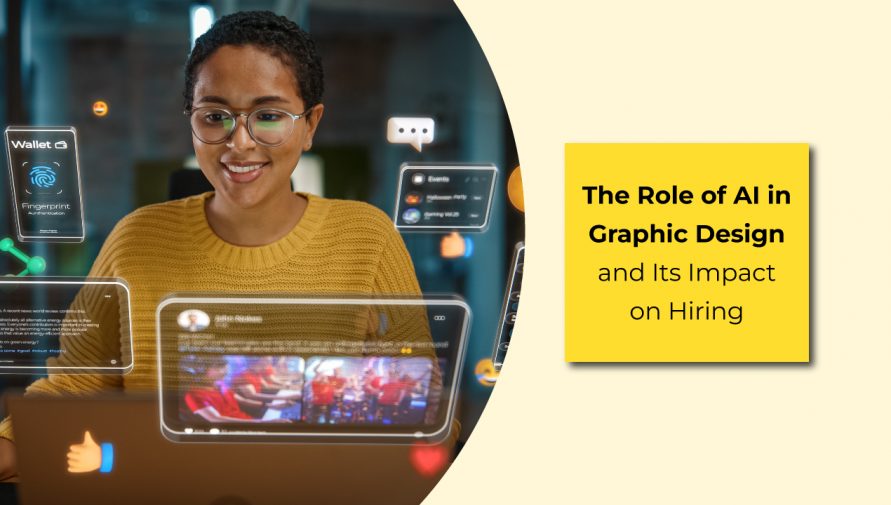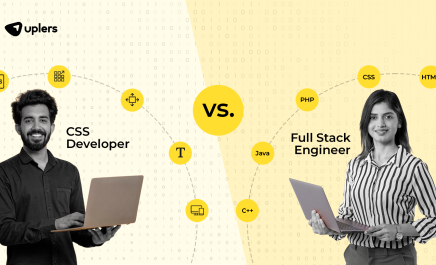The Role of AI in Graphic Design and Its Impact on Hiring
- Sathvik Poojary
- July 21, 2024
- 5 Minute Read

Artificial intelligence is revolutionizing graphic design, generating both excitement and skepticism. Some fear that AI might replace human designers, while others see it as a powerful tool that enhances creativity and efficiency.
Many businesses are leveraging AI to boost inspiration and streamline workflows. For instance, Adobe introduced AI-driven tools like Adobe Firefly and Adobe Sensei. Similarly, Canva launched Magic Design, and ClickUp developed the AI Knowledge Manager. Additionally, innovative solutions like Jasper.ai, Khroma, Looka, and Midjourney are making a significant impact.
AI’s potential to transform graphic design is immense. For example, Nutella used AI in its “Nutella Unica” campaign to create 7 million unique packaging designs for limited edition jars. When used ethically, AI can greatly improve efficiency, adaptability, and personalization, providing businesses with a competitive edge.
Benefits of AI in Graphic Design
While artificial intelligence is a powerful tool in graphic design, it cannot replace human designers or replicate that distinctive human touch that makes visual art uniquely dynamic and compelling to draw emotional connections.
When balanced and leveraged as an ally, not a substitution, AI in graphic design can lead to:
1. Greater Efficiency and Productivity
Similar to other tech industries, AI can help automate mundane, time-consuming tasks, freeing up teams to spend more time on strategic and creative aspects of a project.
It can also help streamline workflow by creating a draft based on specific parameters such as brand guidelines, theme, layout, patterns, data-driven insights, etc. Then, designers can fine-tune the results using their in-depth understanding of the client’s requirements.
2. Enhancing Creativity and Innovation
Consider AI a helpful team member who can assist with first drafts, brainstorming ideas, and generating ideas and perspectives designers may not have considered.
Leveraging a wide-ranging library of design templates, assets, and trends, AI design tools can serve as copilots to help push the boundaries of what is possible in the arts. By providing multiple iterations of the same design, they can also be valuable tools for assessing and redefining what works and what doesn’t.
AI-Driven Design Trends for 2024
AI in graphic designs can enhance workflows, creativity, and innovation to deliver incredible value by working smarter, not harder. Here are a few key AI-driven design trends in 2024:
1. AI-Powered Photorealism
AI-powered graphic design technology and real-time rendering have paved the way for innovative photorealistic images and avatars.
Recent research has shown that some AI-generated faces are now indistinguishable from human faces. To speed up production, iterations, and workflows, photorealism can be expected to see an uptick as it is faster, uses fewer resources, and is affordable. For gaming, VR, and AR industries, this advancement can significantly transform visuals and enhance the immersive user experience.
2. AI-Driven Motion Graphics and Visual Effects
AI-powered tools such as Adobe Character Animator, Toon Boom Harmony, and more can help enhance the animation industry by automating redundant tasks and speeding up production.
For designers and VFX artists, this development can free them up for the more creative aspects of the process and assist them in the more time-consuming tasks like tweening, color processing, rotoscoping, and rendering. For businesses, this allows for swifter production times, reduced costs, and enhanced quality.
3. Laser-Focused Hyper-Personalization in UI and UX Design
AI technology allows for highly personalized user experiences by quickly creating and testing many design options. Platforms like Netflix, Spotify, and Google’s Gemini use AI to tailor interfaces to individual preferences, making them more intuitive and responsive to user needs.
Impact on the Hiring Process
Graphic designers have always combined art and technology. To adapt to changing market demands, they should enhance their skills and adopt new AI-powered design tools.

Here are new skill requirements for graphic designers adept in AI-powered tools:
- Proficiency in popular graphic design software tools such as Adobe Creative Cloud and other relevant tools
- Proficiency in new AI graphic design tools such as Khroma, Looka, Jasper.ai, Midjourney, Let’s Enhance, and DALL•E 3 to enhance efficiency and productivity
- Typography skills and understanding new AI-fueled trends
- Experience in branding, logo design, and creating visual identities for businesses
- Adaptability, continuous learning, and openness to learning new tools, techniques, and technologies
- Communication skills to understand requirements, collaborate with team members, and translate them using AI-powered tools to generate quality results
Moreover, the hiring process for graphic designers has changed to include mastery of new design software, tools, principles, and concepts. AI can also be leveraged in the candidate screening and selection process by setting parameters for design styles, portfolios, key skills, experience, and more.
Balancing Human Creativity with AI
While AI technology can streamline the graphic design process, workflow, and time-consuming tasks, it is not a substitute for human creativity.
For millennia, human artists, creatives, and innovators have discovered new ways to share messages, draw connections, and integrate emotional depth in art. By drawing on cultural nuance, human empathy, and emotional intelligence, human designers continue to identify new ways to connect with people beyond data input and parameters.
AI technology should augment natural human creativity and innovation.
To strategically integrate AI into design processes and workflows without losing the human touch, consider the following:
- Selecting AI tools that enhance the graphic design workflow and customer experience but do not serve as a replacement for human intervention
- Leveraging AI design tools for ideation, brainstorming, and data analysis
- Training your teams with skills that allow them to use new AI-powered tools and functionality effectively
- Balancing automation and creative human oversight in generating design iterations
Challenges and Ethical Considerations
The evolving opportunities and functionality that come with AI in graphic design are seemingly endless. However, several pros and cons come with leveraging AI tools in graphic design, including ethical concerns.

Here are a few of the various disadvantages and challenges of using AI tools in graphic design:
- There is a significant learning curve in adopting complex AI design tools correctly and ethically, especially for people with little to no design experience
- Limits in trained datasets and algorithms can impact how far you can push the tool to create customized designs
- Limited flexibility to handle super-specific, minor changes based on feedback
- The temptation to replace human graphic designers and user research with faster AI design tools
- Disclosure of usage of generative AI in design work
- Fairness and copyright concerns
Preparing Your Team for AI Integration
Effectively preparing and training your team to adapt to AI graphic design tools can be challenging but achievable.
Here are a few key strategies to help your organization and talented teams leverage the potential of AI:
1. Training And Development For Existing Staff
- Research AI-powered design tools, evaluate their features, and assess whether they can be integrated into your workflow
- Identify gaps and opportunities to improve efficiency in your workflow that can be automated
- Offer training and learning opportunities for staff to extend AI capabilities
2. Hiring Strategies For AI-Savvy Designers
It is important to consider AI’s impact on graphic design hiring processes. If you are looking to hire graphic designers who are proficient in multiple AI design tools, there are a few strategies to consider:
- Proficiency with design software and AI tools.
- Clearly articulate your company’s values, culture, and ethical stance on AI usage.
- Assess previous work and design style.
- Request disclosure of AI tool usage in their designs.
Future Outlook: AI and the Graphic Design Industry
Graphic design isn’t going away any time soon, and neither is the human need for authenticity. Graphic design is transforming various spheres, from workflows and upskilling to business decisions and hiring. Yet, even in the AI area, human creativity remains invaluable.
When hiring graphic designers, it’s crucial to strike a balance between technology and the human touch. Make sure you seek candidates who blend proficiency with AI tools and traditional design skills, valuing creativity and emotional depth that AI alone cannot replicate. This approach ensures that your team remains innovative and effective, harnessing the best of both worlds to drive future success.

Thank you for submitting the details!
We will keep your information safe. Feel free to contact us with any questions at hello@uplers.com
Please check your email for next steps shared by Robert.

















